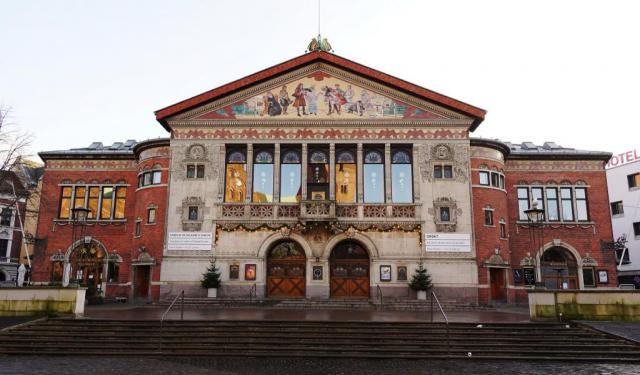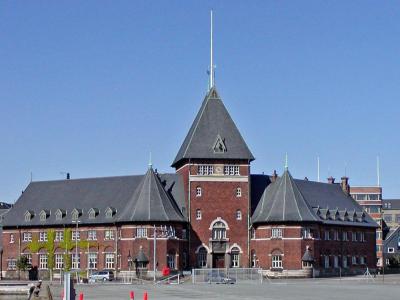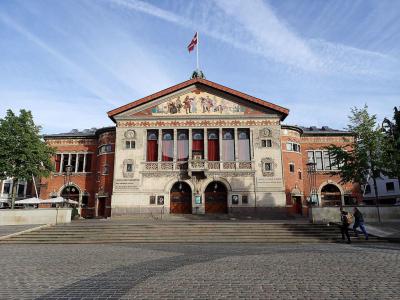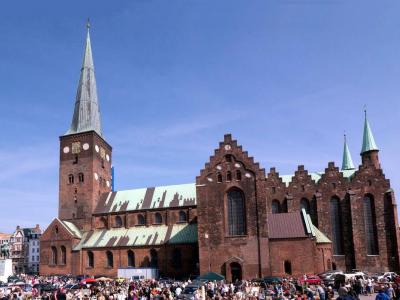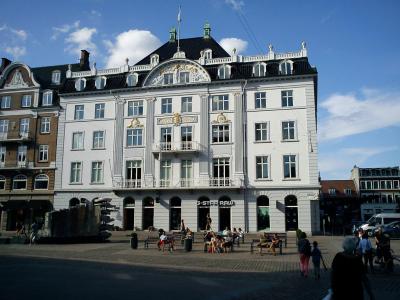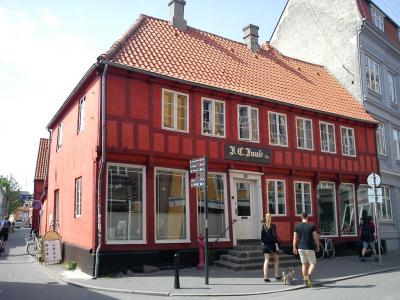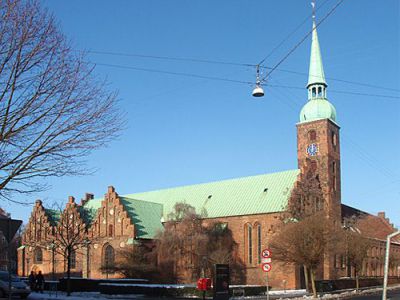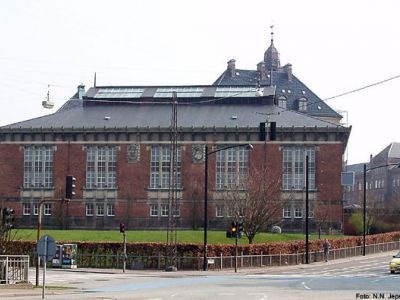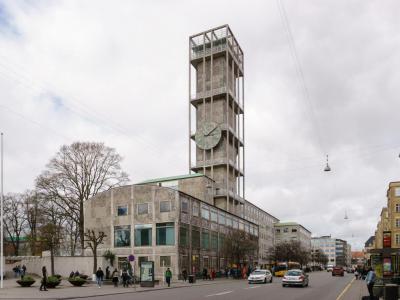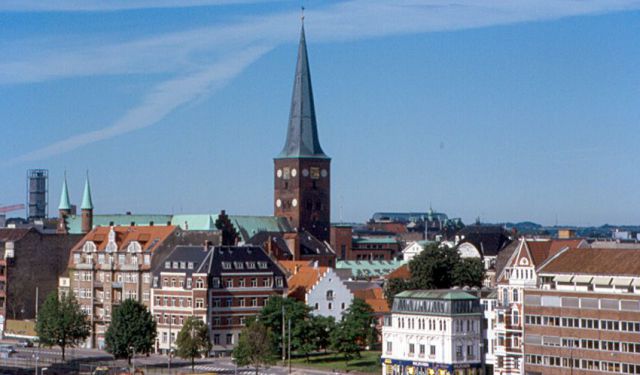Historical Architectures Walking Tour (Self Guided), Aarhus
Among other attractions, Aarhus, Denmark, boasts a variety of eye-catching historical buildings, a good number of which were designed by the famous Danish architect, Hack Kampmann.
Among such landmarks is the Aarhus Custom House (Toldboden), standing as a testament to the city's maritime heritage. The Aarhus Theater, with its elegant facade, showcases the city's commitment to the arts and culture. Nearby, the imposing Aarhus Cathedral is a symbol of faith and architectural prowess, dating back to the 12th century.
Moving through the city, one encounters the grandeur of Hotel Royal, a historic hotel that has welcomed guests since 1838. Juul's House (Juuls Gard), its timber-framed structure, offers a glimpse into Aarhus's merchant history, while the Gothic Church of Our Lady (Vor Frue Kirke), a serene oasis amidst the city bustle, inspires reverence and awe.
For those interested in the city's economic history, the Danish National Business Archives offer a wealth of information and insight into Aarhus's commercial evolution. Meanwhile, Aarhus City Hall, a symbol of civic pride, showcases a distinctive design, blending modernity and tradition.
Finally, Aarhus Central Station serves as a gateway to the city, its architectural style reflecting the importance of transportation in Aarhus's development.
The historical architecture of Aarhus is a living reminder of the generations who came before us, shaping this lovely city's identity and character. We hereby encourage you to take a stroll through Aarhus and discover the beauty of its historical architecture firsthand to enrich your understanding of its remarkable legacy.
Among such landmarks is the Aarhus Custom House (Toldboden), standing as a testament to the city's maritime heritage. The Aarhus Theater, with its elegant facade, showcases the city's commitment to the arts and culture. Nearby, the imposing Aarhus Cathedral is a symbol of faith and architectural prowess, dating back to the 12th century.
Moving through the city, one encounters the grandeur of Hotel Royal, a historic hotel that has welcomed guests since 1838. Juul's House (Juuls Gard), its timber-framed structure, offers a glimpse into Aarhus's merchant history, while the Gothic Church of Our Lady (Vor Frue Kirke), a serene oasis amidst the city bustle, inspires reverence and awe.
For those interested in the city's economic history, the Danish National Business Archives offer a wealth of information and insight into Aarhus's commercial evolution. Meanwhile, Aarhus City Hall, a symbol of civic pride, showcases a distinctive design, blending modernity and tradition.
Finally, Aarhus Central Station serves as a gateway to the city, its architectural style reflecting the importance of transportation in Aarhus's development.
The historical architecture of Aarhus is a living reminder of the generations who came before us, shaping this lovely city's identity and character. We hereby encourage you to take a stroll through Aarhus and discover the beauty of its historical architecture firsthand to enrich your understanding of its remarkable legacy.
How it works: Download the app "GPSmyCity: Walks in 1K+ Cities" from Apple App Store or Google Play Store to your mobile phone or tablet. The app turns your mobile device into a personal tour guide and its built-in GPS navigation functions guide you from one tour stop to next. The app works offline, so no data plan is needed when traveling abroad.
Historical Architectures Walking Tour Map
Guide Name: Historical Architectures Walking Tour
Guide Location: Denmark » Aarhus (See other walking tours in Aarhus)
Guide Type: Self-guided Walking Tour (Sightseeing)
# of Attractions: 9
Tour Duration: 2 Hour(s)
Travel Distance: 2.9 Km or 1.8 Miles
Author: rose
Sight(s) Featured in This Guide:
Guide Location: Denmark » Aarhus (See other walking tours in Aarhus)
Guide Type: Self-guided Walking Tour (Sightseeing)
# of Attractions: 9
Tour Duration: 2 Hour(s)
Travel Distance: 2.9 Km or 1.8 Miles
Author: rose
Sight(s) Featured in This Guide:
- Toldboden (Aarhus Custom House)
- Aarhus Theater
- Aarhus Cathedral
- Hotel Royal
- Juuls Gård (Juul's House)
- Vor Frue Kirke (Church of Our Lady)
- Danish National Business Archives
- Aarhus City Hall
- Aarhus Central Station
1) Toldboden (Aarhus Custom House)
The Aarhus Custom House stands as a notable architectural landmark on the harbor front of Aarhus. Completed in 1898 and designed by the esteemed royal building inspector Hack Kampmann, this building is often celebrated as one of his finest creations. Kampmann's influence on Aarhus is significant, with other notable designs in the city including the Marselisborg Palace and Aarhus Teater.
Originally built between 1895 and 1897 to serve the Danish state, the Aarhus Custom House is the fourth customs building in the city's history. Its predecessors included structures strategically placed along the Aarhus Å and near the city's port to facilitate maritime and customs activities. Kampmann's design marked a new era, situating the building in a prime location to oversee the bustling harbor area.
The architectural style of the Aarhus Custom House is predominantly National Romanticism, a style that emphasizes folk elements and national identity, which was quite popular in Scandinavia at the turn of the 20th century. After serving its initial purpose until the mid-1990s, the building saw various uses, including a period when it hosted the architecture school and served as a student hostel. In 2004, the Tækker Group acquired the building, undertaking extensive renovations in collaboration with cultural authorities to preserve the distinct Kampmann style. Today, it houses a restaurant, continuing to serve a communal role in Aarhus.
Located in the central part of the city, the Aarhus Custom House not only stands as a testament to the architectural heritage of Hack Kampmann but also symbolizes the historical evolution of civic and commercial life in Aarhus. The preservation and adaptive reuse of this historic building demonstrate a commitment to maintaining cultural heritage while adapting to contemporary uses.
Originally built between 1895 and 1897 to serve the Danish state, the Aarhus Custom House is the fourth customs building in the city's history. Its predecessors included structures strategically placed along the Aarhus Å and near the city's port to facilitate maritime and customs activities. Kampmann's design marked a new era, situating the building in a prime location to oversee the bustling harbor area.
The architectural style of the Aarhus Custom House is predominantly National Romanticism, a style that emphasizes folk elements and national identity, which was quite popular in Scandinavia at the turn of the 20th century. After serving its initial purpose until the mid-1990s, the building saw various uses, including a period when it hosted the architecture school and served as a student hostel. In 2004, the Tækker Group acquired the building, undertaking extensive renovations in collaboration with cultural authorities to preserve the distinct Kampmann style. Today, it houses a restaurant, continuing to serve a communal role in Aarhus.
Located in the central part of the city, the Aarhus Custom House not only stands as a testament to the architectural heritage of Hack Kampmann but also symbolizes the historical evolution of civic and commercial life in Aarhus. The preservation and adaptive reuse of this historic building demonstrate a commitment to maintaining cultural heritage while adapting to contemporary uses.
2) Aarhus Theater
The Aarhus Theater in Aarhus stands as a remarkable example of the Jugend style, reflecting the architectural elegance of the late 19th century. This iconic structure was built in the 1890s following a civic initiative. Designed by the distinguished architect Hack Kampmann, who is also noted for other significant buildings in Aarhus like Marselisborg Slot, the theater was officially inaugurated on September 15, 1900.
Aarhus Theater has been a listed landmark since 1990, preserving its historical and architectural significance. The building captivates with its ornate Jugendstil façade, which invites visitors into a world of cultural richness and artistic splendor. Once inside, the grandeur continues with luxurious decorations including glittering chandeliers, gold-adorned ceilings, and lavish interiors that maintain their original allure, reinforcing the theater's status as a cultural powerhouse in Denmark's second-largest city.
The theater features four stages, collectively accommodating up to 1200 seats, and showcases a variety of performances that highlight its commitment to the arts. Notably, the façade of the theater is adorned with a ceramic mosaic by Karl Hansen-Reistrup, depicting a scene from Ludvig Holberg’s play "Maskerade," a nod to Holberg's legacy as the father of Danish comedy. This choice of decoration underscores the theater's function and its cultural heritage.
The theater's promenade is embellished with stucco scenes from notable Danish musical comedies, enhancing the thematic continuity of Danish theatrical tradition. Additionally, the theater's connection to local heritage is symbolized under its balcony, where the town arms of Aarhus are displayed, featuring maritime and protective symbols that reference both the city's history and its maritime location.
Interestingly, while initial plans by Kampmann included decorating the theater’s roof with classical motifs, these were ultimately replaced by more gothic elements, such as a troll/dragon/gargoyle/devil figure. This element became a topic of local intrigue and speculation, particularly regarding Kampmann’s intentions, though such rumors are often discounted given his extensive work on the neighboring cathedral.
Aarhus Theater has been a listed landmark since 1990, preserving its historical and architectural significance. The building captivates with its ornate Jugendstil façade, which invites visitors into a world of cultural richness and artistic splendor. Once inside, the grandeur continues with luxurious decorations including glittering chandeliers, gold-adorned ceilings, and lavish interiors that maintain their original allure, reinforcing the theater's status as a cultural powerhouse in Denmark's second-largest city.
The theater features four stages, collectively accommodating up to 1200 seats, and showcases a variety of performances that highlight its commitment to the arts. Notably, the façade of the theater is adorned with a ceramic mosaic by Karl Hansen-Reistrup, depicting a scene from Ludvig Holberg’s play "Maskerade," a nod to Holberg's legacy as the father of Danish comedy. This choice of decoration underscores the theater's function and its cultural heritage.
The theater's promenade is embellished with stucco scenes from notable Danish musical comedies, enhancing the thematic continuity of Danish theatrical tradition. Additionally, the theater's connection to local heritage is symbolized under its balcony, where the town arms of Aarhus are displayed, featuring maritime and protective symbols that reference both the city's history and its maritime location.
Interestingly, while initial plans by Kampmann included decorating the theater’s roof with classical motifs, these were ultimately replaced by more gothic elements, such as a troll/dragon/gargoyle/devil figure. This element became a topic of local intrigue and speculation, particularly regarding Kampmann’s intentions, though such rumors are often discounted given his extensive work on the neighboring cathedral.
3) Aarhus Cathedral (must see)
Aarhus Cathedral is a Church of Denmark cathedral that was previously a part of the Roman Catholic church. The Gothic and Romanesque cathedral was completed in 1300 and dedicated to Saint Clement, the patron saint of sailors.
Construction of the church started around 1190. It was built around Saint Clement's church, a timber church built in 1102. The Romanesque architectural style included half-rounded arches, a flat timber ceiling and four chapels.
The cathedral suffered great damage in 1330 when a fire burned much of Aarhus. It was abandoned until 1449 when it was renovated and enlarged. The new design of the church used Gothic vaulting with high windows and a lengthened nave. It is now both the tallest and longest church in Denmark at 305 feet long and 315 feet high. The current, 314-foot tower was built in 1931.
There are more frescoes in Aarhus Cathedral than in any church in the country. They were painted between 1470 and 1520. Likewise, the painting of Saint Christopher and Saint Clement are the tallest in Denmark. The cathedral's one stained glass window was created by Emanuel Vigeland in 1926. At almost 46-feet tall, it is the largest stained glass window in Denmark.
Construction of the church started around 1190. It was built around Saint Clement's church, a timber church built in 1102. The Romanesque architectural style included half-rounded arches, a flat timber ceiling and four chapels.
The cathedral suffered great damage in 1330 when a fire burned much of Aarhus. It was abandoned until 1449 when it was renovated and enlarged. The new design of the church used Gothic vaulting with high windows and a lengthened nave. It is now both the tallest and longest church in Denmark at 305 feet long and 315 feet high. The current, 314-foot tower was built in 1931.
There are more frescoes in Aarhus Cathedral than in any church in the country. They were painted between 1470 and 1520. Likewise, the painting of Saint Christopher and Saint Clement are the tallest in Denmark. The cathedral's one stained glass window was created by Emanuel Vigeland in 1926. At almost 46-feet tall, it is the largest stained glass window in Denmark.
4) Hotel Royal
Hotel Royal in Aarhus is a landmark of luxury and historical significance located in the central Indre By neighborhood, with views of Aarhus Cathedral and Store Torv Square. Founded in 1838 by Niels Larsen, the hotel was originally constructed from two Neoclassical-style buildings, one of which was the Kongens Gaard (King's House). It rapidly became a hub for the elite, attracting royalty, politicians, celebrities, and socialites, establishing itself as the city's most prestigious lodging.
The hotel's growth includes several renovations and expansions, notably in 1865, and 1868, and an addition of a new building in 1902 designed by Eggert Achen and Thorkel Møller. Despite changing ownership multiple times since its inception, it has continuously catered to the upper classes. Noteworthy offerings over the years have included stables, a horse-drawn bus service, and even car fueling and cleaning services as transportation evolved.
The hotel's social life has been centered around the Marble Room, built in 1913. Over the decades, this room has hosted a jazz club featuring international artists like Count Basie and Duke Ellington, a cinema, a steakhouse, and a discotheque. In 1991, the space was transformed into the Casino Royale. In terms of architecture, the hotel features an exquisite Neoclassical white facade, and a 1991 renovation introduced an art déco-style entrance reminiscent of early 20th-century Paris metro stations.
Art and culture are deeply embedded in the Hotel Royal's identity. The hotel boasts around 300 artworks, including pieces by renowned artists such as Asger Jorn, Karel Appel, Joan Miró, Wassily Kandinsky, and Polish painter Andrzej Kowalczyk, who is noted for his ceiling paintings in the hotel that depict significant events in Aarhus's history. The walls feature paintings of 53 Danish monarchs, tracing back to Gorm the Old.
Today, Hotel Royal stands as a fusion of historical grandeur and contemporary luxury, making it one of Denmark’s highest-ranked hotels and a testament to its rich cultural heritage and continued appeal to distinguished guests.
The hotel's growth includes several renovations and expansions, notably in 1865, and 1868, and an addition of a new building in 1902 designed by Eggert Achen and Thorkel Møller. Despite changing ownership multiple times since its inception, it has continuously catered to the upper classes. Noteworthy offerings over the years have included stables, a horse-drawn bus service, and even car fueling and cleaning services as transportation evolved.
The hotel's social life has been centered around the Marble Room, built in 1913. Over the decades, this room has hosted a jazz club featuring international artists like Count Basie and Duke Ellington, a cinema, a steakhouse, and a discotheque. In 1991, the space was transformed into the Casino Royale. In terms of architecture, the hotel features an exquisite Neoclassical white facade, and a 1991 renovation introduced an art déco-style entrance reminiscent of early 20th-century Paris metro stations.
Art and culture are deeply embedded in the Hotel Royal's identity. The hotel boasts around 300 artworks, including pieces by renowned artists such as Asger Jorn, Karel Appel, Joan Miró, Wassily Kandinsky, and Polish painter Andrzej Kowalczyk, who is noted for his ceiling paintings in the hotel that depict significant events in Aarhus's history. The walls feature paintings of 53 Danish monarchs, tracing back to Gorm the Old.
Today, Hotel Royal stands as a fusion of historical grandeur and contemporary luxury, making it one of Denmark’s highest-ranked hotels and a testament to its rich cultural heritage and continued appeal to distinguished guests.
5) Juuls Gård (Juul's House)
Juul's House is a historic structure located in Aarhus. Constructed in 1629, this building is officially recognized and preserved as part of the national Danish registry of protected buildings and places, under the supervision of the Danish Heritage Agency. It stands as one of the oldest buildings in the city. Since 1842, it has operated as a paint shop, making it the oldest of its kind in Denmark.
Originally constructed as two separate houses around 1600, these buildings were merged into one entity in 1629. For the first 200 years, it served dual functions as both a store and residence, although specific details from this period remain sparse.
In 1830, the building's story shifted when Abraham Lewis, a Jewish merchant, bought it and opened a store. By 1837, financial troubles led to his bankruptcy and imprisonment for debt, after which he vanished from public records. In 1842, I.C. Juul took over, starting a new era by selling various items such as herring, cigars, and cognac, before eventually specializing in imported and mixed paint.
To this day, the establishment continues to operate as a paint shop and retains the Juul name. The building's long history is palpable to visitors, exemplified by a paint bucket autographed by most employees since 1880 and a collection of paint samples spanning a century.
Architecturally, Juul's House is a quintessential example of a half-timbered Renaissance house. The structure features four wings arranged around a central courtyard, each constructed in different periods. The main facade on Mejlgade Street was formed by joining two earlier houses in 1629. The wing along the neighboring property at no. 23 dates back to around 1600, while the main building was erected slightly later. The back building was added in the late 1700s, and in 1851, a lower, narrower wing was built along Graven Street, completing the estate's four-winged layout with its internal courtyard.
Juul's House not only reflects the architectural styles and urban development of its time but also offers a vivid slice of Danish commercial history, preserved within the heart of Aarhus.
Originally constructed as two separate houses around 1600, these buildings were merged into one entity in 1629. For the first 200 years, it served dual functions as both a store and residence, although specific details from this period remain sparse.
In 1830, the building's story shifted when Abraham Lewis, a Jewish merchant, bought it and opened a store. By 1837, financial troubles led to his bankruptcy and imprisonment for debt, after which he vanished from public records. In 1842, I.C. Juul took over, starting a new era by selling various items such as herring, cigars, and cognac, before eventually specializing in imported and mixed paint.
To this day, the establishment continues to operate as a paint shop and retains the Juul name. The building's long history is palpable to visitors, exemplified by a paint bucket autographed by most employees since 1880 and a collection of paint samples spanning a century.
Architecturally, Juul's House is a quintessential example of a half-timbered Renaissance house. The structure features four wings arranged around a central courtyard, each constructed in different periods. The main facade on Mejlgade Street was formed by joining two earlier houses in 1629. The wing along the neighboring property at no. 23 dates back to around 1600, while the main building was erected slightly later. The back building was added in the late 1700s, and in 1851, a lower, narrower wing was built along Graven Street, completing the estate's four-winged layout with its internal courtyard.
Juul's House not only reflects the architectural styles and urban development of its time but also offers a vivid slice of Danish commercial history, preserved within the heart of Aarhus.
6) Vor Frue Kirke (Church of Our Lady)
The Church of Our Lady, located in the heart of Aarhus, is a historic structure with origins dating back to the Middle Ages. Originally completed in 1060 AD as a stone crypt church after the destruction of a prior wooden structure, it represents the earliest extant stone church in Scandinavia. This crypt, discovered during renovations in the 1950s, now serves as a unique feature beneath the main building, hosting weekly masses since its restoration and reopening in 1957.
Initially named Saint Nicholas' Church, the site underwent significant transformations, particularly with the establishment of a Dominican priory, Vor Frue Kloster, in 1240, of which the church was a part. This expansion included the addition of a large tower between 1250 and 1500, enhancing its architectural stature. Following the Reformation in Denmark, King Christian III repurposed the surrounding priory buildings into a hospital for the sick and poor and renamed the church to the Church of Our Lady. This marked the church as a central hub for clerical activities in the region.
Further renovations took place in 2000, continuing to preserve and highlight its historical significance. Notably, the crypt-church excavation in the 1950s revealed two graves and 23 coins from the 14th century, providing insights into the church's medieval past. This crypt was originally constructed as a strategic ecclesiastical endeavor by Christian, the first bishop of Aarhus, to counteract the influence of Archbishop Adalbert of Hamburg-Bremen.
Today, the Church of Our Lady stands as a testament to the rich religious and architectural history of Aarhus, bridging past and present with its ancient foundations and continuous role in the community's spiritual life.
Initially named Saint Nicholas' Church, the site underwent significant transformations, particularly with the establishment of a Dominican priory, Vor Frue Kloster, in 1240, of which the church was a part. This expansion included the addition of a large tower between 1250 and 1500, enhancing its architectural stature. Following the Reformation in Denmark, King Christian III repurposed the surrounding priory buildings into a hospital for the sick and poor and renamed the church to the Church of Our Lady. This marked the church as a central hub for clerical activities in the region.
Further renovations took place in 2000, continuing to preserve and highlight its historical significance. Notably, the crypt-church excavation in the 1950s revealed two graves and 23 coins from the 14th century, providing insights into the church's medieval past. This crypt was originally constructed as a strategic ecclesiastical endeavor by Christian, the first bishop of Aarhus, to counteract the influence of Archbishop Adalbert of Hamburg-Bremen.
Today, the Church of Our Lady stands as a testament to the rich religious and architectural history of Aarhus, bridging past and present with its ancient foundations and continuous role in the community's spiritual life.
7) Danish National Business Archives
The Danish National Business Archives, located in Aarhus, is an esteemed institution housed in a historically significant building constructed between 1898 and 1902. Designed by the Royal surveyor and architect Hack Kampmann, the structure is a prime example of National Romanticism and Jugendstil architecture. The building's detailed ornamentation was crafted with contributions from the artist K. Hansen Reistrup.
Originally serving as the seat of the National Library of Aarhus until 1963, the building facilitated the central administrative operations for municipal libraries across Denmark, as well as the University Library of the University of Aarhus. Following the relocation of the National Library to the University of Aarhus, the building transitioned to its current role as the seat of the Danish National Business Archives.
As part of the Danish National Archives system, which underwent reorganization in 2014, the building now plays a crucial role in preserving and archiving historically valuable records from various central authorities, including ministries, agencies, and national organizations. The collective archive system was formerly known as the Danish State Archives but is now universally referred to as The National Archives.
The Danish National Archives, inclusive of the Business Archives in Aarhus, boasts an extensive collection with more than 400 kilometers of original paper records and over 4,500 databases reflecting various aspects of Danish society. These records are invaluable resources for researchers and the general public alike, offering deep insights into the administrative and societal fabric of Denmark.
Visitors to the archives can access the Reading Room, where they may seek assistance from archival staff with specialized expertise in different fields. To facilitate research, the National Archives provide numerous search aids such as guides, inventories, and leaflets. While the majority of these materials are in Danish, essential resources related to foreign policy and genealogy are available in English, aiding both local and international researchers in navigating the extensive archival collections.
Originally serving as the seat of the National Library of Aarhus until 1963, the building facilitated the central administrative operations for municipal libraries across Denmark, as well as the University Library of the University of Aarhus. Following the relocation of the National Library to the University of Aarhus, the building transitioned to its current role as the seat of the Danish National Business Archives.
As part of the Danish National Archives system, which underwent reorganization in 2014, the building now plays a crucial role in preserving and archiving historically valuable records from various central authorities, including ministries, agencies, and national organizations. The collective archive system was formerly known as the Danish State Archives but is now universally referred to as The National Archives.
The Danish National Archives, inclusive of the Business Archives in Aarhus, boasts an extensive collection with more than 400 kilometers of original paper records and over 4,500 databases reflecting various aspects of Danish society. These records are invaluable resources for researchers and the general public alike, offering deep insights into the administrative and societal fabric of Denmark.
Visitors to the archives can access the Reading Room, where they may seek assistance from archival staff with specialized expertise in different fields. To facilitate research, the National Archives provide numerous search aids such as guides, inventories, and leaflets. While the majority of these materials are in Danish, essential resources related to foreign policy and genealogy are available in English, aiding both local and international researchers in navigating the extensive archival collections.
8) Aarhus City Hall
Aarhus City Hall was completed in 1941 from a design by architects Arne Jacobsen and Erik Moller. It was designed to replace the Old City Hall, built in 1857, which is now home to the Museum of Women's History.
The building includes a 196-foot tall tower and a tower clock with a face that is almost 23-feet wide. The city hall is made with concrete plated with grey marble imported from Porsgrunn in Norway. Architectural details are completed on the exterior in copper that has since been covered in verdigris.
The entrance of the Aarhus City Hall is in the City Hall Park. The park includes a cobbled plaza and an avenue lined in linden trees. City Hall Square offers a fountain and a sculpture known as Ceres Bronden.
The interior of the city hall has oak parquet floors, patterned ceramic tiles, glass walls and a large number of brass and bronze accents. Visitors can take guided tours inside the city hall on Tuesdays, Thursdays and Saturdays.
The building includes a 196-foot tall tower and a tower clock with a face that is almost 23-feet wide. The city hall is made with concrete plated with grey marble imported from Porsgrunn in Norway. Architectural details are completed on the exterior in copper that has since been covered in verdigris.
The entrance of the Aarhus City Hall is in the City Hall Park. The park includes a cobbled plaza and an avenue lined in linden trees. City Hall Square offers a fountain and a sculpture known as Ceres Bronden.
The interior of the city hall has oak parquet floors, patterned ceramic tiles, glass walls and a large number of brass and bronze accents. Visitors can take guided tours inside the city hall on Tuesdays, Thursdays and Saturdays.
9) Aarhus Central Station
Aarhus Central Station is the principal railway station in Aarhus. This pivotal hub manages an impressive annual footfall of 6.3 million passengers, making it the busiest railway station outside the Copenhagen area. Strategically positioned in the city center, the station borders the Midtbyen and Frederiksbjerg districts, featuring access points from Banegård Square (Banegårdspladsen).
Designed as a through station, it contains four platforms and serves as a key node on the East Jutland railway line. It functions as the terminus for the Grenaa Line and Odder Line. The station offers a range of connections including international routes to Hamburg and Berlin, InterCity services to Aalborg/Frederikshavn and Copenhagen, regional routes throughout Jutland, and light rail services to Grenå and Odder.
The railway's history in Aarhus dates back to 1862 when the first line from Aarhus to Randers was inaugurated, and constructed by the British civil engineering firm Peto, Brassey, and Betts. This initial station, launched on September 2, 1862, was located near Ryesgade, incorporating administration buildings and railway works.
By 1884, due to increasing demand, a larger Neo-Renaissance-style station designed by Thomas Arboe and William August Thulstrup, possibly inspired by Bonn Central Station, was constructed. Continued growth necessitated a third construction phase, and in 1927, the current Aarhus Central Station was erected under the guidance of Danish State Railway architect K.T. Seest as part of a comprehensive area development plan.
Today, the station is not just a transit point but a commercial center as well. It houses a large ticket kiosk, public amenities, a McDonald's, two 7-Elevens, and several other retail outlets. The attached three-story Bruun's Galleri shopping center enriches the station's offering with 93 stores, eateries, cafés, and a substantial underground parking facility. The ground floor’s Bruuns Arkade adds more dining options and dual-level bicycle parking.
Designed as a through station, it contains four platforms and serves as a key node on the East Jutland railway line. It functions as the terminus for the Grenaa Line and Odder Line. The station offers a range of connections including international routes to Hamburg and Berlin, InterCity services to Aalborg/Frederikshavn and Copenhagen, regional routes throughout Jutland, and light rail services to Grenå and Odder.
The railway's history in Aarhus dates back to 1862 when the first line from Aarhus to Randers was inaugurated, and constructed by the British civil engineering firm Peto, Brassey, and Betts. This initial station, launched on September 2, 1862, was located near Ryesgade, incorporating administration buildings and railway works.
By 1884, due to increasing demand, a larger Neo-Renaissance-style station designed by Thomas Arboe and William August Thulstrup, possibly inspired by Bonn Central Station, was constructed. Continued growth necessitated a third construction phase, and in 1927, the current Aarhus Central Station was erected under the guidance of Danish State Railway architect K.T. Seest as part of a comprehensive area development plan.
Today, the station is not just a transit point but a commercial center as well. It houses a large ticket kiosk, public amenities, a McDonald's, two 7-Elevens, and several other retail outlets. The attached three-story Bruun's Galleri shopping center enriches the station's offering with 93 stores, eateries, cafés, and a substantial underground parking facility. The ground floor’s Bruuns Arkade adds more dining options and dual-level bicycle parking.
Walking Tours in Aarhus, Denmark
Create Your Own Walk in Aarhus
Creating your own self-guided walk in Aarhus is easy and fun. Choose the city attractions that you want to see and a walk route map will be created just for you. You can even set your hotel as the start point of the walk.
Aarhus Introduction Walking Tour
Aarhus is the second-largest city in Denmark. It is also one of the oldest cities in the country with roots that date to the 8th century when Vikings built a small settlement at the mouse of AArhus River encircled by an earthen rampart and a moat. Back then, Aarhus was called "Aros" which was the old Danish word for "river mouth".
During the Middle Ages, Aarhus was a... view more
Tour Duration: 2 Hour(s)
Travel Distance: 3.0 Km or 1.9 Miles
During the Middle Ages, Aarhus was a... view more
Tour Duration: 2 Hour(s)
Travel Distance: 3.0 Km or 1.9 Miles
The Most Popular Cities
/ view all
